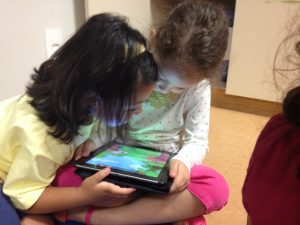
“KidsFun_iPads” by CTJ Online is licensed under CC BY-NC-ND 2.0
BC’s Digital Literacy Framework has some good points for building kids’ digital skills. Importantly, for Kindergarten and elementary school in general, it specifies, right at the top, that teacher modelling will be necessary before a gradual release of responsibility. Most kids are capable of exploring an iPad by themselves and this can be relatively safe for pre-readers as long as there are colourful child-orientated game apps on it. However, once those kids can read and spell, adult supervision is required in order to make kids safer. Years ago, when Shrek was popular, my preteen daughter typed Shrek into a Google search and came across an image of a very large naked woman, painted green, entitled “Shrek’s Mom”. She was horrified, not necessarily because of the image but because she believed it was wrong to see naked people and she thought her dad would be mad. After she came to me in tears, it turned into a teachable moment, but I wish I had prepared her better before turning her loose on technology. Has anyone created one of these frameworks for parents? There should be a pamphlet or something wrapped up inside every tablet, computer, or game console that advises parents about keeping their kids safe on the internet and the gradual release of responsibility. I don’t think keeping kids off the internet entirely is a good way to keep them safe. It just means they’ll be learning all the hard lessons later or at a friend’s house.
At school, our teacher-librarians have curated safe places for the children to search out information of interest inside our Digital Learning Commons. There are recognizable icons and pictures that lead pre-readers to video clips and articles that can be read through text-to-speech technology. When we introduce these things, there is a conversation about using “safe search” engines rather than the big G they see on the tools at home.
In Kindergarten, the biggest challenge is supporting the children as they use digital technology. If there’s 20 kids and just me, that is a tricky thing to manage. I gave up on the computer lab because it would take the entire 25 minute block to get them all signed on. We pretty much just stick to iPads with no passwords. Weekly, the teacher-librarian and I sign out the class set of iPads and work together to support the class during a specific technology block. What I believe would be more useful would be to have a set of 5 iPads that I can keep in my classroom to use in small group settings or, if during free choice time, a student wants to look something up on monkeys, I can help them do that. In either plan, it would be important to emphasize that the iPads are tools, not toys. School iPads are not babysitters.
Other than iPads, we have been dipping our toes into coding games and the robotic mouse which is cool. I would like to do more with this.
A large piece of the Framework is about digital citizenship. In Kindergarten, kids are learning about ordinary, run-of the-mill citizenship and personal protection every day.
a. safety – It would be easy to connect digital citizenship in that context. We talk about most people they meet being good people, but we need to use our instincts and stay out of reach from “bad apples”. We can easily incorporate online people and online bad apples into those same lessons/conversations.
b. privacy – This would definitely be guided lessons. We could talk about passwords with regard to my “Teacher iPad”. We could talk about how websites track purchasing activity during our unit on wants and needs right before Christmas. We could talk about pop-up ads that they may see on game apps.
c. relationships – we could incorporate some Skype or FaceTime with relatives into our sharing time (aka, show and tell). We already talk about how parents can send their digital photos to me with email and airdrop.
d. cyberbullying – I think this is a bit premature for Kindergarten. Unless they are participating in online interactive video games at home, I think we can include this in social learning at school. If someone is saying or doing something that upsets you, let a grown up know so we can help that someone to be a better friend. In Kindergarten, bullying is a frequently misused word, but that’s another blog.
e. digital footprint – ‘Mom, Mrs. Westwood says you should ask my permission before you put my photo on Facebook because a bad apple might see it.’ I’m not sure if I would step into that one yet. Besides isn’t putting embarrassing photos of your kids on Facebook a parental imperative? Still, someone needs to talk to them about the bathtub photos.
g. creative credit & copyright – We talk about ownership over creative work every time someone scribbles on someone else’s drawing, or when someone takes someone’s drawing out of the recycling, they need to ask for permission to take it . They get it. We can talk about copying and pasting images when we do our class butterfly report.
f, h, i and j have no bullet points for Kindergarten so I won’t comment on them but I do wish there was a bullet point on limiting the use of technology so kids are still playing and building in real life, still interacting with adults and other children, and getting physical activity. I had a little guy once tell me, “I only play video games. I’m better at it than my brother. I don’t like toys.” Yikes! This is a big question for me in Kindergarten. When 4, 5 and 6 year olds are still learning the very basics, how much digital technology do we want in there? How do I find the balance between the sand box and iPads?
Leave a Reply